The Lenovo Ideapad Y700 Laptop Review
by Brett Howse on February 11, 2016 8:00 AM ESTDisplay
Lenovo offers two displays in the Y700, but luckily both are IPS panels. Several low cost gaming laptops are still shipping with TN panels as the base offering, and that’s very unfortunate in 2016, so it’s great to see Lenovo offering IPS on all of the models. The display panel in the Y700 review unit is an LGD04A7, which is the 1920x1080 offering. This is a 6-bit panel, so it's still a lower-end IPS offering, and utilizes a full RGB stripe.
Since this laptop has Optimus, there is no option of G-SYNC on this panel, since G-SYNC is only possible if Optimus is not available. This is something I hope NVIDIA can solve, because the laptops that are more often going to benefit from G-SYNC are the same laptops with the less powerful GPUs like this model. Due to the way that Optimus works though, it may be very difficult to get this to function.
To test display accuracy, we use SpectraCal’s CalMAN 5 suite with a custom workflow. Contrast and brightness levels are measured with an X-Rite i1Display Pro colorimeter, and color accuracy is measured with an X-Rite i1Pro2 spectrophotometer. As a refresher, color accuracy is measured as a Delta-E, which is the “distance” between the correct color and the color portrayed on the display. Values under 1.0 are considered imperceptible, with values under 3.0 as what we would consider acceptable.
Brightness and Contrast
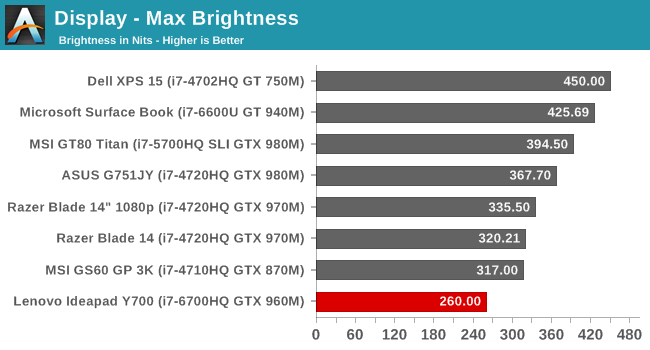
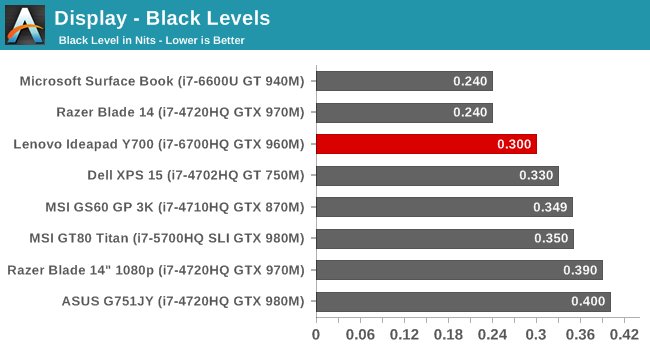
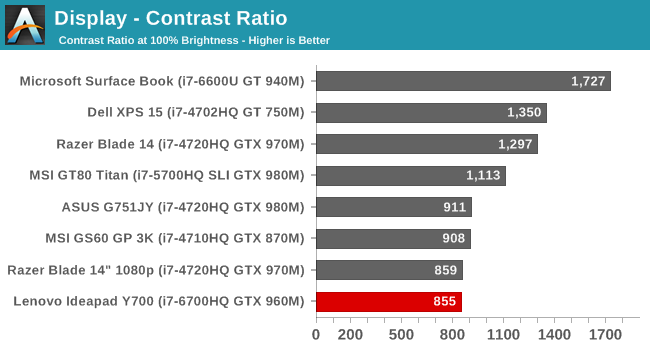
The Lenovo Y700 has a display that is not very bright. 260 nits is enough for indoor use, but if you were to use it outdoors it would be a struggle. It also has only an average contrast ratio for an IPS panel. There have been some nice advances in LCD contrast in the last little bit, but they seem to be relegated to higher end devices like the Surface Book for the time being.
Grayscale
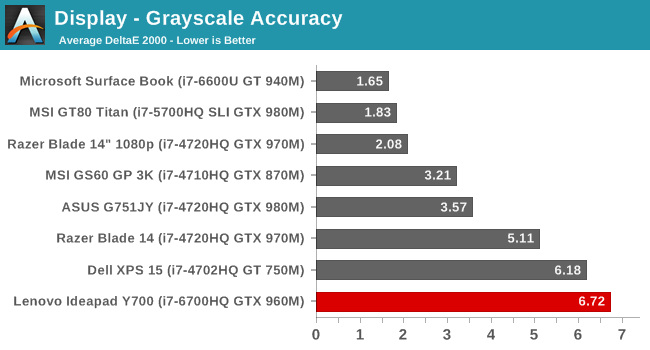
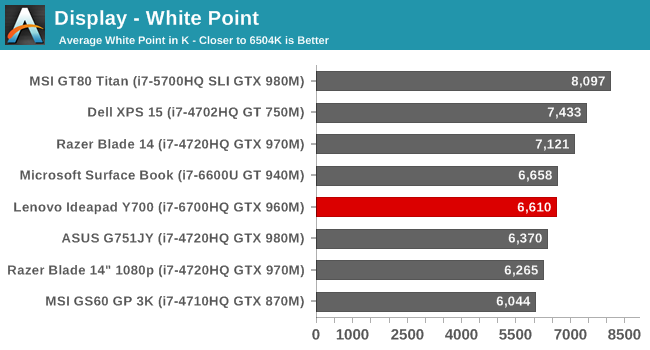
Here we start to see some issues with the Y700 display. At a targeted 200 nits, the Y700’s display has a pretty large drop off in both red and blue levels, causing the white levels to shift into the green spectrum. Amazingly the white shows as close to the target temperature of 6504K despite the color issues, highlighting the issues of using a single number to try to portray something with color.
Gamut
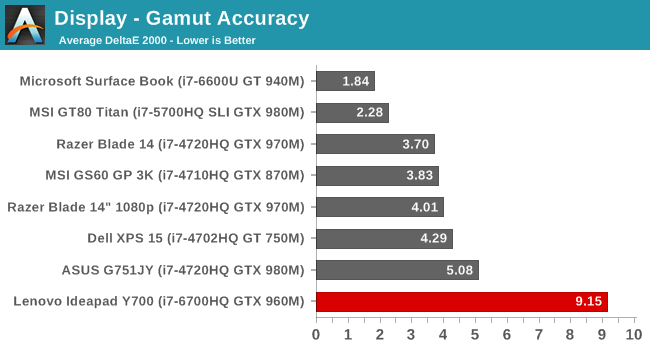
Normally I don’t bother with Gamut graphs, but on the Y700 its worth taking a look at. On this test we can see the glaringly obvious issue of the backlight used in the Y700. This is a narrow-band LED backlight, and it can’t produce anywhere near the entire sRGB gamut. The blue levels are well under what is necessary to cover the entire range, and red and green are also well under. This doesn’t bode well for the rest of the tests.
Saturation
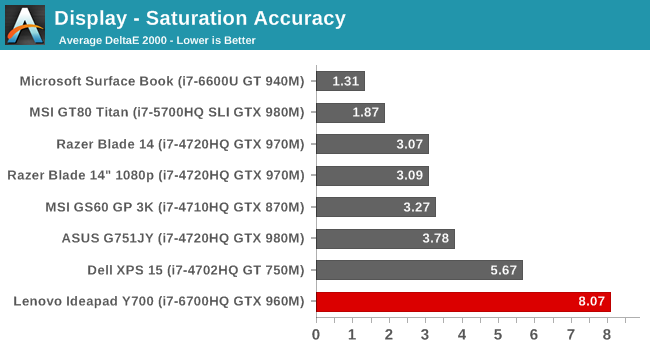
With the saturation sweep you can more easily see the compressed nature of the narrow-band backlight. All of the colors are well under what they should be for any given point in the color space, with 100% blue topping out on the green side of about 75% of the range. This hurts magenta quite a bit, as does the red which tops out around 78% or so.
Gretag Macbeth
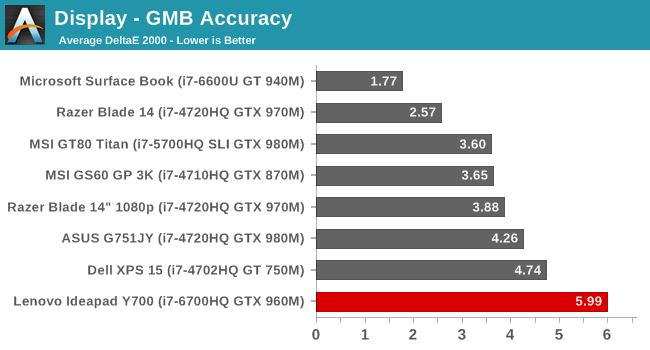
Our most comprehensive color test is the Gretag Macbeth test, which targets many more colors, including a lot of flesh tones. Although the overall average is about a dE of 6, there are large gaps in the results where its not even close.
Color Checker
To put the above numbers into a context that’s easier to understand at a glance, we use the Color Checker tests. The bottom of the color swatch is the correct color, and the top half shows what the display produced. Just as a reminder, the color checker results are a relative comparison, because any inaccuracies in your own display will skew the results.
On the grayscale swatches, you can clearly see the green coming out of the whites from quite early on. The color swatches make it very obvious in the shortcomings especially for blue. 100% blue on this display is far too light, and it’s very easy to see by eye.
Calibrated Results
We can use CalMAN to run a calibration of the display, but bear in mind that calibration on a display without an adjustable 3D Look Up Table (LUT) is not going to be able to do anything with the actual colors. Grayscale can be fixed, and sometimes this can pull some of the colors back a bit too, but sometimes it also hurts the color accuracy.
Once calibrated, the grayscale is much better behaved, but 100% white is not fixable because the display runs out of gamut. But as expected, the saturation and gamut results are basically unchanged. GMB does come down a bit due to the more accurate gray levels.
Overall this is a pretty disappointing display. It’s great that it is an IPS panel, so you don’t suffer from the terrible viewing angles of TN, but the backlight in the Y700 just can’t cut it. I wasn’t surprised that the display wasn’t calibrated at the factory when they are targeting this price point, but it would be great if it could come a bit closer to hitting more of the already small sRGB color space.


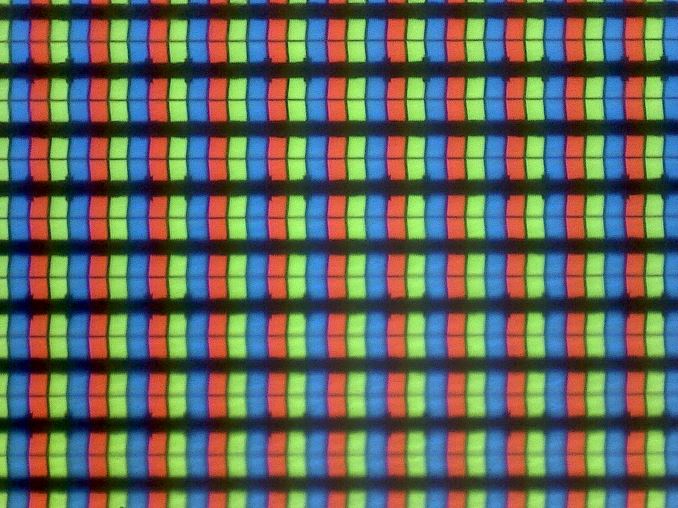






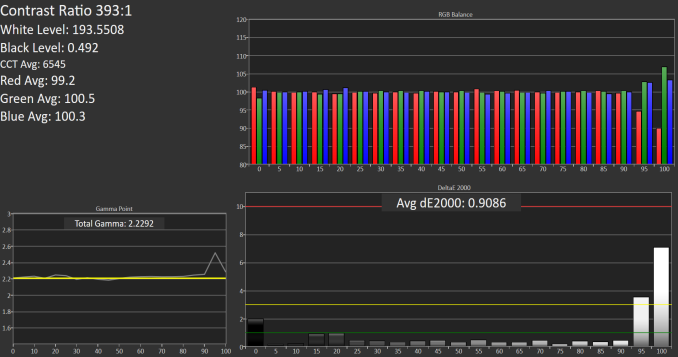
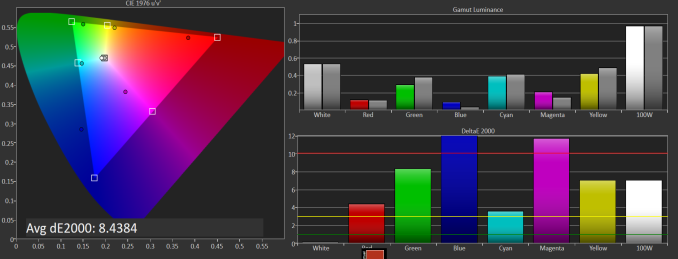

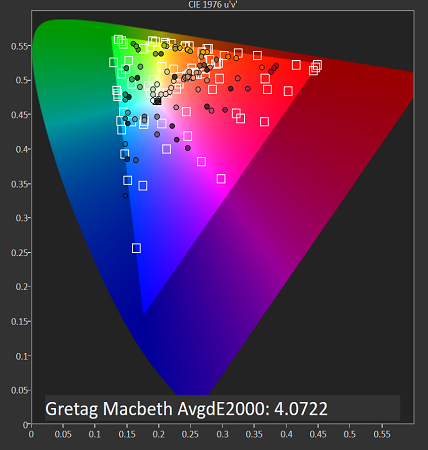








52 Comments
View All Comments
zepi - Thursday, February 11, 2016 - link
All gaming laptops have been terribly un-exciting for some time due to GPU-vendors being very stuck with 28nm process. Before they get to move on, there is very little any OEM can do to actually bring the market considerably forwards...Aouniat - Thursday, February 11, 2016 - link
The Dell Inspiron i7559 is in my view a better value for money compared to the Lenovo.godlyatheist - Friday, February 12, 2016 - link
It has an even worse screen than the Lenovo, and this one is bad enough.Teknobug - Thursday, February 11, 2016 - link
Maybe Lenovo should just stick to business laptops.coder111 - Thursday, February 11, 2016 - link
Ok, does Lenovo still ship laptops with spyware built into BIOS that even Windows reinstall cannot remove? The one which breaks HTTPS and leaks things like your on-line banking?https://en.wikipedia.org/wiki/Superfish#Lenovo_sec...
Stay well away if that's still the case.
mrcaffeinex - Thursday, February 11, 2016 - link
After the incident, Lenovo released a utility and instructions to remove the unwanted software: https://support.lenovo.com/us/en/product_security/... As far as I know, it was never built into the BIOS, however it was built into the recovery image that shipped with the computers. Regardless, a clean installation of Windows from the official media (not what the manufacturer gives you) is always the best way to go, in my experience.neo_1221 - Thursday, February 11, 2016 - link
Given how fast Lenovo backtracked once they were caught, I doubt they're still shipping anything with Superfish. And like mrcaffeinex says, I don't think it was ever embedded in the BIOS - just the recovery image.dsraa - Thursday, February 11, 2016 - link
Trollin hard are we??They already too care of that like a year ago, where have you been under a rock, still wearing your tinfoil hat????
rpjkw11 - Monday, February 15, 2016 - link
I'm still wearing a tinfoil hat I suppose. Anyway, there are many other laptops out there that are as good or better than Lenovo, so I refuse to buy from a company I distrust.stomu9 - Thursday, February 11, 2016 - link
Possible error:page 1 specification chart, CPU - i7-6600HQ is not an existing model, would this be i7-6700HQ (2.6-3.5 GHz)?